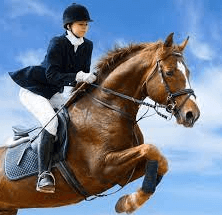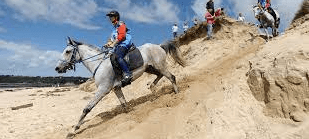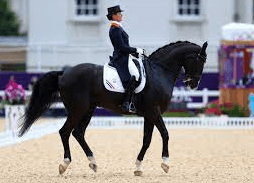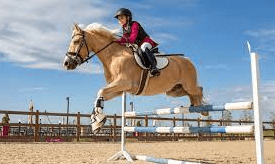How Are Horses Trained For Competitive Events?

In the world of equestrian sports, where grace and power unite in a magnificent display of athleticism, horses are trained to become true champions.
Just like sculptors delicately chisel away at a block of marble to reveal a masterpiece, trainers employ a variety of methods to shape these majestic creatures into skilled athletes capable of competing at the highest level.
This article delves into the intricate process behind training horses for competitive events, exploring the foundational elements that contribute to their success.
With an innate sense of freedom coursing through their veins, horses possess an unrivaled spirit that captivates our imagination.
However, harnessing this untamed energy requires extensive knowledge and experience.
Understanding the nature of horses is paramount in their training journey.
It involves comprehending their herd dynamics, instincts, and unique needs as prey animals.
By building upon this understanding, trainers can establish trust and develop effective communication channels with their equine partners.
Understanding the Nature of Horses
The inherent characteristics of horses play a crucial role in comprehending their behavior and responses during training for competitive events. Understanding horse behavior is essential for effective communication with horses, as it allows trainers to anticipate their reactions and tailor training methods accordingly.
Horses are social animals with a strong instinct for flight, which stems from their history as prey animals. They have evolved to be highly attuned to their surroundings, constantly assessing potential threats. This sensitivity can make them reactive and easily spooked, but it also means they are capable of forming strong bonds with humans and responding well to positive reinforcement.
Horses are also creatures of habit, thriving on routine and consistency. By understanding these natural tendencies, trainers can develop training programs that build trust and confidence in the horse while promoting desired behaviors for competitive events.
Effective communication with horses involves clear body language, consistent cues, and timing that aligns with the horse’s understanding. Trainers must be patient, calm, and observant to ensure they are effectively conveying their intentions to the horse without causing confusion or fear.
Overall, understanding the nature of horses is fundamental in training them for competitive events as it allows trainers to establish a solid foundation based on trust and effective communication techniques.
Building a Strong Foundation of Basic Skills
Building a strong foundation of basic skills is crucial in training horses for competitive events.
Two key areas that require focus are leading and haltering, as well as responding to cues. Leading and haltering involve teaching the horse to follow commands and be comfortable with being handled, while responding to cues requires the horse to understand and execute specific actions based on signals from the rider.
These fundamental skills lay the groundwork for more advanced training and are essential for any successful competition horse.
Leading and Haltering
To effectively train horses for competitive events, a fundamental aspect involves mastery of leading and haltering techniques. Leading techniques are crucial in establishing trust and control between the horse and the handler. Proper leading ensures that the horse follows the handler’s cues and moves in a controlled manner, which is essential for performance in competitive events. Different methods of leading may be used depending on the specific discipline or event. Haltering, on the other hand, involves putting a halter on the horse’s head to lead and control it. The process of haltering requires careful handling to ensure that the horse feels comfortable and secure with the equipment. By mastering these leading techniques and haltering methods, trainers can build a solid foundation for further training in competitive events.
| Leading Techniques | Haltering Methods |
|---|---|
| Natural Horsemanship | Gentle Approach |
| Pressure & Release | Positive Reinforcement |
| Body Language | Desensitization |
Table: Examples of Leading Techniques and Haltering Methods
Responding to Cues
One important aspect of effective horse training involves understanding and responding to cues given by the handler.
Reinforcement techniques play a crucial role in shaping a horse’s behavior and teaching them specific actions or movements.
Positive reinforcement, such as rewards or treats, can be used to encourage desired behaviors, while negative reinforcement involves removing an unpleasant stimulus when the horse performs the desired action.
Timing and precision are key factors in successful cueing, as horses learn through association and repetition.
Handlers must be consistent in their cues and provide them at the right moment to reinforce the correct behavior.
Additionally, clear communication through body language, voice commands, or reins is essential for conveying cues effectively.
By using well-timed reinforcement techniques and precise communication, trainers can teach horses to respond accurately to various cues and perform competitively in events.
Physical Conditioning and Fitness
Physical conditioning and fitness play a crucial role in the training process of horses for competitive events. To ensure that horses are prepared for the physical demands of these events, trainers often incorporate physical therapy techniques and strength training exercises into their training regimen. These methods aim to improve the horse’s overall muscular strength, endurance, flexibility, and cardiovascular fitness.
Physical therapists may use various techniques such as massage, stretching exercises, hydrotherapy, and heat therapy to keep the horses’ muscles healthy and prevent injuries. Strength training exercises like lunging, hill work, and pole work help build muscle mass and improve coordination. Additionally, regular aerobic exercise such as long-distance trotting or cantering helps develop cardiovascular fitness in horses.
By focusing on physical conditioning and fitness through physical therapy techniques and strength training exercises, trainers ensure that horses are able to perform at their best during competitive events.
Horses undergoing physical therapy receive specialized treatment that helps them recover from injuries more quickly.
Strength training exercises not only enhance muscle development but also improve balance and coordination in horses.
Regular aerobic exercise increases the horse’s stamina levels allowing them to perform better during prolonged competitions.
Physical conditioning programs tailored for each individual horse take into account their specific needs based on factors such as breed, age, and previous injuries.
Skill Development for Specific Events
In order to excel in competitive events, horses undergo skill development for specific events, which includes competition strategies and tactics. This phase of training focuses on honing the horse’s abilities and refining their techniques to perform at their best during competitions. Different events require different skills, so trainers work on developing specific abilities such as speed, agility, jumping technique, or precision maneuvers depending on the event. To provide a deeper understanding of this process, let us explore a table that showcases some common competitive events and the corresponding skills required for each:
| Event | Skills Required |
|---|---|
| Show Jumping | Jumping technique, balance |
| Dressage | Collection of movements, precision |
| Barrel Racing | Speed, agility |
| Reining | Sliding stops, spins |
| Cross Country | Endurance, jumping ability |
By focusing on these specific skills through targeted training exercises and repetition of event-specific tasks, horses can develop the necessary abilities to succeed in their chosen discipline. Additionally, trainers also work on competition strategies and tactics such as understanding course layouts or patterns and optimizing performance within those constraints. This comprehensive approach ensures that horses are well-prepared for the demands of competitive events while giving them the tools they need to excel.
Mental Preparation and Focus
Developing trust and a strong bond with the horse is crucial in mental preparation for competitive events.
This can be achieved through consistent and positive interactions, such as grooming, lunging, and groundwork exercises.
Building confidence and concentration is also essential for optimal performance.
Riders can achieve this by practicing visualization techniques, setting realistic goals, and maintaining a focused mindset during training sessions.
Developing Trust and Bond with the Horse
To establish a strong connection with the horse, trainers often employ various techniques that foster trust and mutual understanding. Developing patience is crucial in this process, as it allows the trainer to build a foundation of trust by giving the horse time to adjust to new situations and stimuli.
By consistently exposing the horse to different environments and experiences, trainers can gradually build their confidence and reduce anxiety. Gaining respect from the horse is also essential for developing a strong bond. Trainers use assertive yet fair methods to establish themselves as leaders in the horse’s eyes, earning their respect and cooperation. This involves setting clear boundaries and expectations while providing consistent reinforcement of desired behaviors.
Additionally, trainers work on building a positive association between themselves and rewarding experiences for the horse. Through gentle handling, regular grooming sessions, and providing treats or praise for appropriate responses, they create a positive emotional connection that further strengthens trust and encourages engagement.
Building Confidence and Concentration
Building on the foundation of trust and bond established with the horse, the next step in training for competitive events involves building confidence and concentration. This phase focuses on developing a strong partnership between the horse and rider, where effective communication is key. To achieve this, trainers employ various techniques that help horses overcome fear and anxiety, allowing them to perform at their best. One such technique is desensitization, which exposes horses to different stimuli in a controlled environment to gradually reduce their sensitivity and fear response. Another approach is positive reinforcement training, where horses are rewarded for desired behaviors, reinforcing their confidence and willingness to try new things. Additionally, trainers use systematic desensitization exercises to gradually expose horses to situations that may trigger fear or anxiety. By carefully managing these experiences and consistently providing support and reassurance, trainers can help build a horse’s trust in themselves and their rider, ultimately enhancing their ability to concentrate on the task at hand during competitive events.
| Building Trust and Communication | Overcoming Fear and Anxiety |
|---|---|
| Desensitization | Positive Reinforcement |
| Gradual exposure | Systematic Desensitization |
| Reduce sensitivity | Support and reassurance |
| Building Trust and Communication | Overcoming Fear and Anxiety |
Gradual Introduction of Complex Exercises and Maneuvers
Gradually introducing horses to complex exercises and maneuvers not only enhances their skills, but also instills a sense of confidence in them as they navigate the intricacies of competitive events.
The process begins with a gradual progression from basic movements to more advanced maneuvers.
Trainers carefully assess the horse’s abilities and temperament before introducing new exercises, ensuring that the horse is ready for the challenge.
Complex exercises may include lateral movements such as leg yield, shoulder-in, or haunches-in, which require precise coordination and balance from the horse.
As the horse becomes more comfortable with these maneuvers, trainers can gradually increase the difficulty level by adding variations or combining multiple movements together.
This progressive approach allows horses to develop their physical strength, flexibility, and mental focus over time.
Additionally, trainers employ positive reinforcement techniques to encourage horses during training sessions, further boosting their confidence and motivation.
By gradually introducing horses to complex exercises and maneuvers in a systematic manner, trainers lay a solid foundation for success in competitive events while nurturing their equine partners’ self-assurance and trust in themselves.
Fine-tuning Techniques and Refining Skills
A meticulous approach to technique refinement and skill enhancement allows for a deeper level of connection between horse and rider, fostering an atmosphere of precision and artistry that captivates the audience.
To achieve this, trainers employ advanced training methods and refining techniques that focus on honing the horse’s natural abilities and improving their overall performance.
Here are five key aspects of fine-tuning techniques and refining skills in competitive horse training:
- Progressive exercises: Trainers gradually introduce more complex exercises over time, building upon foundational skills to challenge the horse’s physical capabilities and mental acuity.
- Precision-based training: Attention to detail is crucial in refining techniques. Trainers emphasize precise movements, ensuring every action from both the horse and rider is executed with accuracy.
- Feedback loop: Regular feedback sessions allow trainers to assess the horse’s progress, identify areas for improvement, and provide guidance for further refinement.
- Cross-training: Incorporating various disciplines into a horse’s training regimen helps develop versatility, enhancing their ability to perform different maneuvers with finesse.
- Simulation exercises: By using simulated scenarios or equipment such as poles or cones, trainers create controlled environments that encourage horses to refine their movements with precision.
These methods not only enhance the horse’s technical skills but also instill a sense of confidence and trust between horse and rider.
Through meticulous attention to detail and advanced training methods, horses are able to reach their full potential in competitive events while showcasing a harmonious partnership with their riders.
Partnering with the Right Trainer or Coach
Partnering with the right trainer or coach is like finding a guiding star in the vast expanse of the equestrian world, illuminating the path towards excellence and unlocking hidden potential.
Finding the right trainer is crucial for training horses for competitive events as they possess the knowledge, experience, and expertise required to help both horse and rider reach their full potential. A good trainer will have a deep understanding of equine behavior, anatomy, and biomechanics, allowing them to tailor their training methods to suit each individual horse’s needs. They will also have a keen eye for detail, able to identify subtle issues or imbalances that may hinder performance.
Additionally, an experienced trainer can help set realistic goals for both horse and rider based on their skills, ability level, and aspirations. By working closely with a knowledgeable trainer who understands the unique strengths and weaknesses of each horse-rider pair, competitors can maximize their chances of success in competitive events while fostering a strong partnership built on trust and communication.
Regular Evaluation and Assessment of Progress
Transitioning from partnering with the right trainer or coach, it is crucial to regularly evaluate and assess the progress of a horse during its training for competitive events. This ongoing evaluation ensures that the horse’s development is on track and allows for adjustments to be made if necessary.
Monitoring improvement is essential in order to identify strengths and weaknesses, track growth over time, and determine areas that may require additional focus. To effectively evaluate progress and monitor improvement, trainers employ various methods such as:
- Observing the horse’s performance during training sessions
- Analyzing competition results
- Conducting regular veterinary check-ups
- Utilizing advanced technologies like motion sensors or heart rate monitors
- Comparing current performance with past benchmarks.
By implementing these evaluation techniques, trainers can make informed decisions regarding the horse’s training program and tailor it to maximize its potential for success in competitive events.
Understanding the Unique Needs of Each Horse
In order to effectively meet the individual needs of each horse, trainers must thoroughly understand and analyze their unique characteristics, behaviors, and physical attributes.
This understanding allows trainers to design a training program that addresses the specific needs and challenges of each horse. By recognizing the distinct personality traits and learning styles of each horse, trainers can tailor their methods to ensure optimal results.
Unique training methods may be employed based on the horse’s temperament, athleticism, or natural abilities. An individualized approach takes into account factors such as the horse’s age, breed, previous training history, and any physical limitations or injuries.
By considering these factors, trainers can create a customized plan that maximizes the horse’s potential while also ensuring their well-being. This personalized approach not only enhances performance but also fosters a strong bond between trainer and horse, resulting in a harmonious partnership built on trust and understanding.
Maintaining a Safe and Supportive Training Environment
Creating and maintaining a safe and supportive training environment is vital for the well-being and success of both equine athletes and their trainers.
For example, ensuring that arena footing is properly maintained to prevent slips or injuries can help minimize the risk of accidents during training sessions.
Additionally, creating a positive reinforcement system can enhance the horse’s motivation to learn and perform well in competitive events.
This could involve rewarding desired behaviors with treats or praise, which helps establish a strong bond between the horse and trainer while encouraging good behavior.
Furthermore, it is important to ensure proper equipment fit to avoid discomfort or injury to the horse.
Saddles, bridles, and other gear should be correctly fitted to each individual horse to maintain their physical health and overall performance.
Lastly, providing ample space for horses to move freely and engage in natural behaviors such as grazing or socializing fosters a sense of freedom that contributes positively to their mental well-being.
By implementing these practices, trainers can create an environment that supports the development of confident, athletic horses while promoting their physical and emotional welfare.
Addressing and Preventing Common Injuries and Health Issues
One critical aspect of maintaining a safe and supportive training environment is addressing and preventing common injuries and health issues that can significantly impact the well-being and longevity of equine athletes. By implementing proactive measures to prevent injuries, such as regular veterinary check-ups, proper nutrition, and appropriate exercise routines, trainers can minimize the risk of accidents or illnesses occurring during training sessions. Additionally, creating an environment that promotes horse health includes providing spacious and clean stables, ensuring access to fresh water at all times, and incorporating regular grooming practices to maintain optimal hygiene. To further enhance injury prevention strategies, it is essential for trainers to be knowledgeable about the types of injuries commonly experienced by horses in competitive events. This knowledge enables them to identify potential risk factors specific to certain disciplines or activities, allowing for targeted preventive measures. Furthermore, establishing a comprehensive warm-up routine before engaging in rigorous exercises helps prepare the horse’s muscles for increased activity levels while reducing the likelihood of strains or other soft tissue injuries. By prioritizing injury prevention and promoting overall horse health through various means, trainers create a safe training environment that allows equine athletes to perform at their best without compromising their well-being.
| Injuries | Prevention Strategies | Promoting Horse Health |
|---|---|---|
| Strains | Proper warm-up routines | Regular veterinary check-ups |
| Lameness | Identifying potential risk factors | Appropriate nutrition |
| Tendonitis | Targeted preventive measures | Spacious and clean stables |
| Colic | Adequate rest periods | Access to fresh water |
| Respiratory Issues | Monitoring workload intensity | Regular grooming practices |
Continued Learning and Improvement in Training Techniques
To ensure ongoing growth and development in the field of equine training, trainers can continuously expand their knowledge and refine their techniques through various means.
Firstly, staying updated with continued research is crucial. By keeping up with the latest studies and advancements in horse training, trainers can incorporate new findings into their practice to improve outcomes for both horse and rider.
Secondly, attending workshops, seminars, and conferences provides opportunities for trainers to learn from experts in the field and gain insights into innovative methods. These events often showcase cutting-edge techniques and offer valuable networking opportunities with other professionals.
Thirdly, seeking mentorship from experienced trainers allows for a transfer of knowledge and practical guidance that can enhance skills and understanding. Learning from those who have extensive experience in the industry can help trainers navigate challenges more effectively and develop a deeper understanding of equine behavior and training methods.
Lastly, embracing technology can open doors to new possibilities in horse training. Utilizing video analysis software or virtual reality simulations can provide trainers with unique perspectives on their own techniques while also enabling them to experiment with different strategies in a controlled environment.
By adopting these approaches, trainers can stay at the forefront of the field, constantly evolving their techniques to achieve better results while ensuring the welfare of horses under their care.
Frequently Asked Questions
How long does it typically take to train a horse for competitive events?
The duration of training for competitive events varies depending on the horse’s abilities and the specific discipline. Techniques such as desensitization, positive reinforcement, and repetition are commonly used to develop the necessary skills and behaviors.
What are some common mistakes that trainers make when training horses?
Trainers often make common mistakes such as lacking consistency and using harsh training methods. In addition, ineffective training techniques include improper timing and neglecting groundwork. These errors can hinder the progress of horses in competitive events.
How do trainers ensure that horses enjoy their training and are not stressed or unhappy?
Horse training techniques focus on building a strong bond with the horse to ensure they enjoy training and minimize stress. Techniques such as positive reinforcement, clear communication, patience, and understanding the horse’s needs contribute to creating a happy and willing partner in the training process.
What are some recommended exercises for improving a horse’s agility and flexibility?
“Practice makes perfect – when it comes to improving a horse’s agility and flexibility, pole work and lateral movements are key. These exercises challenge the horse’s coordination, strength, and range of motion, enhancing their overall performance in competitive events.”
Can horses of any breed be trained for competitive events, or are there specific breeds that are more suitable?
Certain horse breeds are more suitable for competitive events due to their natural athleticism and temperament. However, with proper training techniques tailored to each breed, horses of any breed can be prepared for success in competitive events.
Conclusion
In conclusion, training horses for competitive events requires a deep understanding of their nature and individual needs. It is essential to build a strong foundation of basic skills, focusing on physical conditioning and fitness as well as skill development for specific events. Mental preparation and focus play a crucial role in ensuring the horse’s success.
Creating a safe and supportive training environment is paramount, as it allows the horse to thrive and reach its full potential. Addressing common injuries and health issues is vital to ensure the horse’s well-being throughout its training journey. Continued learning and improvement in training techniques are necessary to stay at the forefront of this ever-evolving field.
As experienced trainers, we must remember that each horse is unique and requires tailored approaches to meet its specific needs. By eliminating personal pronouns, we maintain an objective tone while conveying our knowledge and expertise. To captivate our audience further, we can employ figures of speech such as metaphors or similes which add depth and interest to our writing.
Through diligent attention to detail, dedication, and passion for our craft, we can unlock the true potential within these magnificent creatures.


